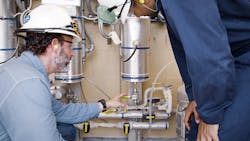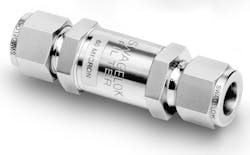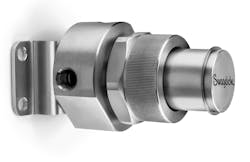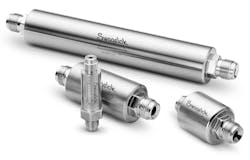Filters are essential to reliable industrial fluid system function
Industrial fluid systems can be damaged if contaminants within the system media are not controlled. Critical components such as valves and regulators can be rendered inoperable. Samples and analyses can be compromised. Fluids and gases may no longer function as intended, and other downstream problems can occur. If the problems are serious enough, fluid system operators may have to return components to the manufacturer and order replacements.
To prevent contamination damage in your systems and avoid these situations, be sure to install the proper filters that will trap and contain particles at crucial stages throughout your systems. By deploying the right gas and liquid filtration methods, you can alleviate many of the problems contaminants cause.
Why fluid system filters are important
It is common for contaminants and particulates to result from industrial processes. Whether they come from mechanical equipment, internal corrosion in tubes and tanks, or dirty process media, unchecked contaminant flow through a fluid system can risk damaging important components such as valves and regulators. Contaminants may also lead to inaccurate analyses.
If left unfiltered, particulates may get trapped between the stem and seat of a valve or regulator. This results in premature wear and damage, which can prevent the component from operating as intended. For example, worn or damaged seats may cause:
- A valve to malfunction and not completely shut off the flow of the system media.
- Excessive downstream pressures.
- Upstream pressure losses if the damage is done to backpressure regulators.
No matter which scenario applies to your situation, each one can result in operational and safety issues in your facility.
Where fluid system filters should be located
Properly placed filters can prevent significant contaminant damage. Though each system is different, there are general locations in most systems where filters will help. They include installation near:
- Cylinder gas dispensers. Gases are often introduced into the system through the use of filters, which normally would reduce the amount of contamination present. If the cylinders are properly maintained, the potential for contamination is low. Over time, the interior surfaces of cylinders may start to flake into the fluid system as the gas is introduced. Placing a filter downstream from the cylinder will alleviate the potential for contamination to make it from the cylinder into the system. If you are using a prefabricated gas distribution system, it may already have filters built into it. If this is the case for your system, there is no reason to install a second filter.
- Valves and regulators. Protecting your valves and regulators is also crucial to the proper functioning of an overall system. Filters upstream from critical valves, regulators or other important components can eliminate the particulates that would typically flow through these components and damage them.
- Pumps. The complexity of many industrial pumps means they may generate small debris that will inadvertently flow into the system. Placing a filter downstream, or in some cases upstream, from a pump can help capture those particulates before they contaminate the rest of the process.
- Online analyzers. To keep an industrial fluid system functioning properly, it is important to use online analyzers, which are some of the most sensitive pieces of equipment in the plant. Contaminated analyzers may compromise the integrity of the samples taken from that point, so installing a filter before the analyzer is important. It cannot be just any filter, however — it must be one that is suited to your specific application. If you install the wrong filter, it may not catch the contaminants, which leads to dirty samples. Oversized filters may cause a lag in between the time the fluid reaches it and when the sample is taken, which can compromise the sample accuracy. Consult with your supplier to determine which filter is most appropriate to use in specific situations.
Three types of filters
Choosing the proper filter is critical to ensuring your fluid system performs properly, which is where working with a reliable supplier can help. With their expertise, your supplier should be able to recommend the right filter for you. Typically, they will suggest one of the following three types:
- Particulate filters. These common filters are used to remove particulate contaminants and are suitable for general industrial gas and liquid filtration. Here, a filter element simply stops particulates from continuing down the process line. In-line particulate filters are typically available for welded applications, in which case they are not serviceable, or non-welded applications, in which they can be removed from the system, cleaned and replaced. Tee-type particulate filters, meanwhile, allow filtering elements to be maintained or replaced without removing the body from the system, creating some maintenance advantages.
- Coalescing filters (Figure 3b). This type of filter is commonly used in online analyzer applications and is suitable for gas filtration. Here, the filter element captures fine liquid droplets suspended in the gas forcing them to coalesce (or form large drops) within the filter element. These drops are forced to the outside of the element by gas flow and gravity; liquid then exits the filter through a drain port.
- Ultrahigh-purity filters (Figure 3c). For applications in which purity must be maintained at all costs, ultrahigh-purity filters are available that can achieve a particle removal rating greater than 99.99% at 0.003 µm at maximum flow rate. These filters are not typically required for general industrial applications and are more commonly found in semiconductor applications.
Once you have selected the right filter, check to ensure it is compatible with the end connections in your system. Investigate the materials from which the filter is made and determine if they can withstand the specific process conditions for your application. For example, some fluids may damage common stainless steels. In those instances, a higher grade of stainless steel may be necessary not only in the filters, but also in the rest of the components.
How to install and maintain your filters
Before a filter can keep contaminants out of your fluid system, it must be installed properly. When considering how to install your filters, think about tube fittings because the two are similar. The flow arrow will decide which ports are inlets and outlets, which will indicate which way the fluid will flow. Read and follow the manufacturer’s instructions for guidance. Since filters must be serviced on a regular basis to remain functional, they should be easily seen and accessible to a maintenance technician. They should also be stored in places where they are protected from damage.
It is important to remember that filters cannot just be installed and forgotten. They should be cleaned and maintained regularly, because over time they will become clogged with contaminants, hindering their proper functioning. You should consider implementing a preventive maintenance schedule for your filters as well as looking for signs that they are not operating properly, like a drop in downstream pressure.
When a filter becomes clogged and cannot be cleaned, follow these steps to remove and replace it:
- Isolate the filter from the system.
- Stabilize the body with a wrench and loosen the filter’s bonnet.
- Remove the dirty or clogged filtration element and replace it with a new one.
Using filters in the right places can keep your critical fluid system components in working order for longer. This allows your facility to produce reliable results and high-quality products. Working with a reputable filter supplier who can advise you on which filters you need for specific applications will help to ensure your industrial fluid system will function well and keep your facility safe and profitable for a long time to come.
Note: An original version of this article appeared on the Swagelok Reference Point blog here.
Bill Ference is a senior applications engineer for Swagelok Company.
Swagelok Company
About the Author
Bill Ference
Senior applications engineer for Swagelok Company
Bill Ference is a senior applications engineer for Swagelok Company.





